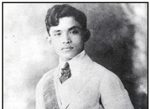While known for the efficacy of its stick and blade fighting techniques, the Filipino martial arts (FMA) is a multi-faceted and complete combat system that incorporates empty hand skills like boxing and wrestling. Wrestling being the most natural form of fighting known to man thrives in the different parts of the Philippines.
Historians Gregorio F. Zaide and Sonia M. Zaide wrote in the book “Jose Rizal: Life, Works, and Writings of a Genius Writer, Scientist and National Hero,” that native wrestling was included in the early education of Jose Rizal, it reads, “His three uncles, brothers of his mother, exerted a good influence on him.
Tio [Uncle] Jose Alberto, who had studied for 11-years in a British school in Calcutta, India, and had traveled in Europe inspired him to develop his artistic ability. Tio Manuel, a husky and athletic man, encouraged him to develop his frail body by means of physical exercises, including horseback riding, walking and wrestling. And Tio Gregorio, a book lover, intensified his voracious reading of good books.”
It is with much certainty that Rizal learned “buno,” a style of native wrestling popular in the Tagalog region where he hailed. Another part of the book narrates how the young Rizal used his knowledge of wrestling in an actual fight, it says, “Jose challenged Pedro to a fight.
The latter readily accepted, thinking that he could easily beat the Calamba boy who was smaller and younger. The two boys wrestled furiously in the classroom, much to the glee of their classmates. Jose, having learned the art of wrestling from his athletic Tio Manuel, defeated the bigger boy. For this feat, he became popular among his classmates.”

Native wrestling was part of the early education of Jose Rizal.
It is perhaps Rizal’s early exposure to native wrestling that whetted his interest to study judo during his brief sojourn in Japan in 1888.
The popularity of “buno” in the region is evident in the fact that the preeminent Tagalog poet Francisco “Balagtas” Baltazar mentioned it along with “arnis” in his epic “Florante at Laura.”
Buno, today is often taught as part of some systems of arnis-escrima in Luzon. It is hard to find authentic instruction on the subject.In the mountainous areas of northern Luzon, another form of native wrestling called “bultong” is practiced among the Ifugaos.
Bultong matches were done on grass or dirt and often were meant to settle disputes involving adultery and landownership. Nid Anima in his book “The Filipino Martial Arts,” wrote of the nature of a bultong match, it reads, “The objective of the bultong, as with other forms of wrestling, is to throw the opponent to the ground.
In the process of a match, they may be elbowing, boxing, scratching, eye-gouging, nose pinching, moustache-pulling, hair-pulling, rib-tickling and other unfair tactics that cannot be avoided, wrestling being what it is: a game that has no room for niceties. Once a contestant’s back is pinned to the ground, the contest is declared over and the combatant atop wins.”
Another form of Filipino wrestling identified with the Visayas particularly the island of Panay is “dumog.” Dumog made it’s way into the American martial arts scene through the teachings of Dan Inosanto. Paul Vunak, a student of Inosanto even produced an instructional video on dumog and how to incorporate it to the jeet kune do street fighting matrix.
In the Philippines, dumog contest were usually held during a town fiesta. Tranquilino Solanoy, a burly Visayan amateur boxer and dumog player told me that such contests were done on dirt and offer prize money. Solanoy narrated that his grandfather who was a champion dumog player retained much of his strength in his old age.
The old man, he said, can still carry sacks of rice and can throw an opponent in a very ballistic manner. Just like in bultong, the objective in dumog is to pin the opponent’s back flat to the ground. Solanoy revealed that some dumog players freely incorporated western wrestling techniques into their repertoire of native dumog maneuvers.
Being an archipelago, the wrestling arts of the Philippines are as diverse as its stick and blade fighting arts. Besides buno, bultong and dumog there are other forms of native Filipino wrestling that need to be investigated and documented among these are: layug (Cebu), pantok (Pampanga), tulot (Pangasinan), gabbo (Ilocos), lampungan (Bicol), dama (Igorot), lawidan (Mangyan), silaga (Samal) and kapulubod (Maranaw).
Wrestling, being the oldest method of fighting known to man evolved into a mere combat sport in many parts of the world. But in the FMA, where weapons techniques are taught to practitioners from day one, wrestling retained much of its original war-like character.
The latter can be summed up in the words of Mickey Dimic in his book “Mixed Martial Arts Unleashed,” he wrote, “The aim in all styles of wrestling is to knock the other person down to the ground and get on top of him or her. The reason for this is that in war, the one on the ground is normally helpless to weapon thrusts from the one on top, or from his or her comrades nearby.”





















